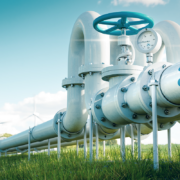
Green Hydrogen – Scaling Clean Power to Reach Net Zero
Roeland Baan is CEO of Topsoe, a Danish engineering company. Roeland tells Nomura Greentech that he is accelerating the rollout of green hydrogen to fight emissions in hard-to-abate industries.
- Topsoe has a proprietary technology that uses 30% fewer electrons to produce the same amount of hydrogen compared to conventional electrolysis
- The European Commission has a target of 10 million tons of green hydrogen produced in Europe by 2030, which would require 100 gigawatts of electrolyzers
- We’re trying to replace a century of energy development with a completely new energy vector in the space of 30 years
What first triggered your interest in sustainability and what made you join Topsoe?
It was really triggered by ‘An Inconvenient Truth’. While I was already environmentally aware, the film brought home the realities of global warming and in subsequent jobs I had a strong ESG and climate focus.
But I must admit that up until this time, I was working in some of the most polluting industries, such as oil and steel.
Topsoe was interesting because I got to know the company years before joining and saw that it was dedicated to developing technologies for energy and environment, but not necessarily for the energy transition.
Topsoe spends 8-9% of revenue on R&D and I remember thinking that’s a huge amount of technology that could be applied to decarbonize the planet. When I was offered the CEO job, I accepted without hesitation, as it allowed me to contribute directly in the fight against climate change. I saw a tremendous opportunity.
I started in May 2020, and by June we had released our 2024 vision to be recognized as a global leader in carbon emission reduction technologies.
Employee shareholders, family stakeholders and our institutional investor, Temasek, backed the plan, so we went full steam ahead.
Topsoe specializes in decarbonizing hard-to-abate sectors which are essential to achieve net zero by 2050. Where do you see the most progress and which technologies are you most excited about?
The biggest issue in the energy transition is that the most exciting and promising technology for hard-to-abate sectors is Power-to-X (using renewables to create an energy carrier, typically, hydrogen).
Power-to-X requires vast amounts of green energy and electrolysis capacity has to be in place. And then there's a green premium that will only be lowered through scale. We have to be successful, since it will be absolutely essential to realize a net zero future.
While Power-to-X is emerging, we should also develop other areas because it’s crucial that we make significant progress in reducing emissions wherever we can already in this decade. That means pursuing two major pathways which are already there at scale, proven and more or less price competitive – renewable fuels, based on biological feedstocks, and low-carbon fuels, based on natural gas with carbon capture.
Hydrogen and its derivatives, such as Methanol and Ammonia, is very much a building block as the basis for the transition. Ultimately, these should be based on renewable energy, but until we have enough renewables available, we should still remove carbon, and we should concentrate on how to do that as fast as possible and then concentrate on the pathway to reach net zero.
You are building Europe's biggest electrolyser plant to produce green hydrogen. Europe needs to grow this capacity 50-fold; how much will you generate?
We have a proprietary technology for a solid oxide electrolyser cell (SOEC) plant that’s different to the mainstream. It’s a first-of-its-kind plant and uses 30% fewer electrons to produce the same amount of hydrogen compared to other electrolysis technologies. As we have a shortage of green electrons in the near-term, this will help mitigate that problem.
At the same time, we believe that power will be expensive for a long time, so using less of it will achieve a more affordable end product.
The plant costs 350 million euros to build and we are considering building a second one in the U.S.
So, we really believe in the technology and want to scale it as fast as possible. The European Commission has a target of 10 million tons of green hydrogen produced in Europe by 2030, which would require 100 gigawatts of electrolyzers.
Currently, we only have 200 megawatts operating in Europe, so it's a huge task. Our 500 megawatts, which is projected to grow to 1.4 gigawatts annually by 2031, is still only a small fraction of what we need constructed by the end of the decade.
Has the U.S. Inflation Reduction Act benefited your business and do you think the E. U. Green Deal needs to provide greater incentives to companies involved in the energy transition?
It's interesting to note that Europe has historically had a tremendous head start over the U.S. and China in developing many of the technologies we need, but ultimately the U.S. has come up with a better mousetrap for incentives - one that’s very simple and provides certainty and security for at least the next decade.
You can easily assess whether you’re eligible and how much you’ll receive in incentives. In Europe, when you add up the incentives it probably amounts to more than the IRA, but obtaining it is very complex, with long application processing periods and a small chance of success.
It's not satisfactory, but the reason is a lack of tax unity. If we had fiscal unity, like the U. S. has, it would be easier to provide tax incentives.
But I don't want to slam our efforts here, because I came from a meeting yesterday in Brussels and there’s tremendous will to make things happen in Europe. It’s just that our politicians have complex waters to navigate.
But at the same time, we’re seeing first-hand some of our European customers mothballing EU projects in favour of American ones. These customers have permits already secured but decide to go where the money flows.
It's dangerous for Europe, because if we lose investments, we potentially lose expertise and we risk losing our technological advantage.
Topsoe is considering a second SOEC plant in the U.S. as a direct result of the IRA.
The IRA is pulling so much capital away from everywhere else that it‘ll succeed in accelerating the energy transition. But that inevitably means other territories will get fewer investment dollars.
Can sustainable aviation fuel make a significant dent in emissions from flying? And how far away are we from mainstream adoption?
Aviation account for 2% of global energy-related CO2 emissions. It might not sound like a lot, but it is. 800 Mt CO2 in 2022 to be precise. And it’s growing. 21.2 gigatons of additional CO2 is expected between 2021 and 2050 from air traffic if the current growth rates in passenger journeys continue.
Sustainable aviation fuel (SAF) can avoid about 90% of emissions. To stay on course for net zero by 2050, 10% of all fuels consumed in aviation by 2030 must be SAF, and by 2050 SAF must account for 70%.
We recently decided that decarbonization of the aviation sector wasn’t going fast enough.
We thought about building SAF plants and producing and selling SAF under our own brand. In the end, we approached our long-term partner Sasol, with whom we have complimentary technologies, and together we’re creating a pure play SAF end-to-end company that’ll develop, build, own, operate and market SAF.
We’re now in the process of incorporating the company, satisfying regulatory and competition hurdles before embarking on our big ambition to quickly get projects off the ground.
So, SAF can make a big difference and we’re spearheading efforts to scale it.
Are you an advocate of technologies like carbon capture and storage or do you believe we should concentrate on faster rollout of renewables?
At this stage, we need to throw everything we have at the problem. Already, with blue technologies (using natural gas) we can remove 99.3% of carbon from a hydrogen process. Of course, you must completely ensure that in the sequestration process it’s gone forever and isn’t being used for enhanced oil recovery.
Eventually, the world wants be free of fossil fuels. But we have to accept that fossil energy will be around for the next 30-60 years, so, let's make it as clean as possible in the meantime and start decarbonizing.
What are your future plans?
We have a full plate. We’re playing in all these different technologies that are central to the energy transition. Our Power-to-X group started with 50 people about 18 months ago and has now grown to 200 people.
The energy transition is a tectonic shift on a par with the Industrial Revolution. We’re trying to replace a century of energy development with a completely new energy vector in the space of 30 years. It's mind boggling. And at the same time the world wants to develop further.
Download a PDF of the full whitepaper
Disclaimer
This content has been prepared by Nomura solely for information purposes, and is not an offer to buy or sell or provide (as the case may be) or a solicitation of an offer to buy or sell or enter into any agreement with respect to any security, product, service (including but not limited to investment advisory services) or investment. The opinions expressed in the content do not constitute investment advice and independent advice should be sought where appropriate.The content contains general information only and does not take into account the individual objectives, financial situation or needs of a person. All information, opinions and estimates expressed in the content are current as of the date of publication, are subject to change without notice, and may become outdated over time. To the extent that any materials or investment services on or referred to in the content are construed to be regulated activities under the local laws of any jurisdiction and are made available to persons resident in such jurisdiction, they shall only be made available through appropriately licenced Nomura entities in that jurisdiction or otherwise through Nomura entities that are exempt from applicable licensing and regulatory requirements in that jurisdiction. For more information please go to https://www.nomuraholdings.com/policy/terms.html.




